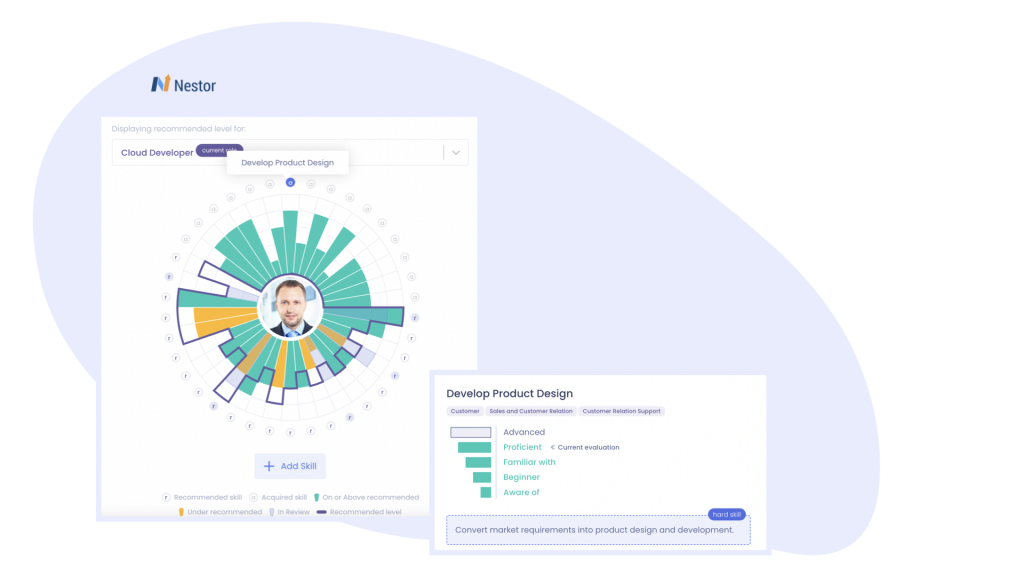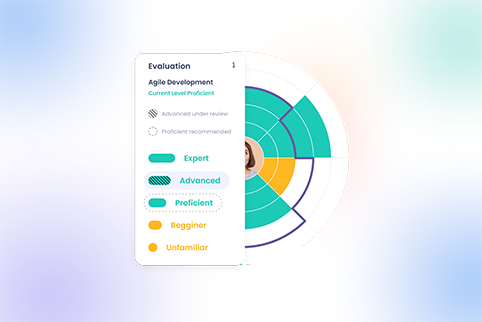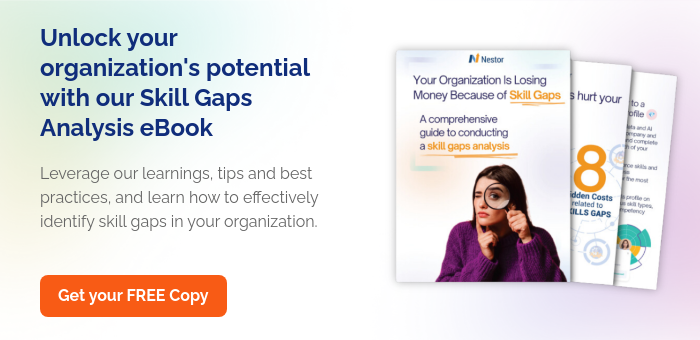Adjacent Skills: Benefits and Strategies on How to Take Advantage of Them
10 min read

In the pursuit of sourcing the ideal talent to propel organizational growth and innovation, employers are progressively adopting innovative approaches that prioritize abilities and adjacent skills over traditional qualifications. According to a report by LinkedIn, putting skills above all else when it comes to hiring might radically change the hiring process and unleash an enormous amount of unrealized potential.
Globally, the pool of potential candidates can increase by nearly 10 times when utilizing a skills-first approach, according to the findings by LinkedIn. This statistic highlights a massive talent pool that frequently remains untapped when hiring practices are disproportionately based on certain standards like work title or college degree. By refocusing on skills, employers can broaden their search and pinpoint candidates and existing employees with diverse backgrounds and experiences, potentially possessing the complementary skills essential for excelling in roles that extend beyond conventional boundaries.
Understanding Adjacent Skills
As the name implies, adjacent skills refer to abilities and knowledge that are directly related or complementary to one’s core competencies. Unlike primary abilities, which form the foundation of one’s expertise in a particular domain, adjacent skills serve to supplement and enhance that expertise, providing individuals with a broader toolset to navigate the complexities of their roles and responsibilities.
To illustrate this concept, let’s look at Antoine’s profile on the Nestor platform to understand his skill landscape comprehensively. As a Cloud Developer, he has a strong skill set that is compatible with his position; these include knowledge of programming languages, cloud computing, and infrastructure management. These core competencies, showcased within the blue boundary on Antoine’s Nestor profile, form the foundation of his expertise.
However, Antoine’s story doesn’t end with his growth of essential Cloud Developer skills. What sets him apart is his continuous development of adjacent skills, represented by the components outside the blue contour. Take, for instance, Antoine’s aptitude for product design. While not directly related to his role, Antoine’s proficiency in product design adds a unique dimension to his professional skill set. This proficiency positions him as a valuable asset in cross-functional teams, where it’s extremely valuable to have both technical and design understanding.

But wait, there’s more! As Antoine improves his knowledge in this complementary skill alongside his primary role, he’s setting the stage for effortless leaps into fields like User Experience (UX) design or product management. With such a diverse skill set under his belt, he isn’t just thriving in the present—he’s paving the way for future career expansion and personal growth.
In today’s dynamic job market, where adaptability is key, employees like Antoine represent a valuable asset. By embracing a mindset of continuous learning and skill diversification, we unlock new possibilities and propel both individuals and organizations toward greater success.
The use of Adjacent Skills in Organizational Development
In the evolving story of the dynamics of the global workforce, a recent study by the World Economic Forum sheds light on a sobering reality: by 2030, an estimated 85 million job vacancies worldwide could remain unfilled due to a lack of applicants with the necessary abilities. In addition to endangering people’s chances for a successful career, this alarming statistic represents a serious threat to the world economy, potentially costing them an estimated $8.5 trillion in lost revenue annually.
In response to this urgent call to action, the notions of complementary skills and reskilling become essential foundations in navigating this shifting framework. Reskilling is the process of acquiring new capabilities or updating existing ones to meet evolving demands, It’s key to maintaining freshness and workforce flexibility. Complementary skills, on the other hand, include capabilities that enhance a person’s adaptability and skillset, adding to their primary abilities. By embracing and integrating these principles into their organizational development strategies, companies can gain access to a multitude of perks.
1. Navigating Skills Gaps
One of the most significant advantages of adjacent skills is their ability to bridge existing skill gaps and address evolving demands in the workforce. Instead of solely focusing on finding candidates who meet every requirement outlined in a job description, organizations can prioritize flexibility and look for applicants who possess related abilities.
As industries undergo rapid transformation fueled by technological advancements and changing market dynamics, they can also foster talent from within by emphasizing adaptability and an openness to learn. This allows employees to evolve into jobs that better suit the changing demands of the company and gain new abilities.
2. Fostering Talent Mobility
Finding complementary abilities among current employees becomes a more efficient procedure when done so within the context of internal mobility. Current workers have already demonstrated their capabilities and potential within the organization, making it easier for talent managers to discern complementary abilities that may not be immediately evident from their current roles.
Professionals equipped with a diverse range of competencies are of great value as they are better positioned to explore new career paths, pursue lateral moves, and seize opportunities for upward mobility.
3. Amplifying Learning and Development Prospects
Adjacent skills are important because they promote a culture of lifelong learning and growth. This helps people stay updated in a constantly changing environment, diversify their knowledge base, and develop new abilities.
For example, an individual with a background in marketing may discover a knack for data analysis—an adjacent skill that complements their existing expertise and opens doors to roles in market research or business intelligence. Similarly, a software engineer may develop proficiency in user experience design, enhancing their ability to deliver user-centric solutions and explore opportunities in product management.
4. Assistance with Workforce Dynamics
Organizations frequently encounter the need for strategic redeployment of personnel to align with shifting priorities and market demands. This process, while often challenging, presents an opportunity to leverage the concept of adjacent skills to facilitate a seamless transition and maximize employee potential. By integrating adjacent skills into redeployment strategies, organizations can optimize workforce dynamics and enhance employee engagement and retention.
Strategies for Integrating Adjacent Skills into Organizational Frameworks
While the benefits of adjacent skills are clear, implementing them effectively requires a strategic approach that combines proactive action with awareness. In the following section, we explore a roadmap designed to facilitate the seamless integration of adjacent skills into your organizational strategy. By utilizing these strategies you can make the most of your workforce’s potential and keep your competitive edge in a market that constantly evolves.
1. Perform a Skills Assessment and Establish Concrete Goals
For the best outcome, is essential to assess the workforce’s skills landscape through employee surveys, performance evaluations, or formal skills assessments. These insights are invaluable for identifying skill gaps and opportunities for development. Also, it’s crucial to establish clear objectives for developing adjacent skills, both individually and organizationally.
For instance, a specific goal for a worker could be to improve their proficiency in a particular programming language within three months to enhance their adaptability to changing project requirements. Utilizing tools like the Nestor platform facilitates this by creating a manageable personalized growth plan, providing insights into the employees’ skill sets.
2. Identifying Specific Skill Sets for Targeted Development
Based on the outcomes of the skills audit and defined objectives, identify the specific adjacent skills that are most relevant and beneficial to pursue. Consider factors such as emerging trends in your industry, evolving job requirements, and areas of strategic importance for your organization. Prioritize skill sets that complement your existing expertise and have the potential to create maximum impact.
3. Allocate Resources to Learning and Development
Dedicate resources towards learning and development initiatives aimed at nurturing adjacent skills among employees. This includes providing access to tailored training programs, educational materials, and skill-enhancing workshops. To make the most of their diverse skill sets and gain knowledge from one another’s experiences, encourage employees to work together on projects that involve multiple departments or teams.
4. Track Progress
Establish metrics and key performance indicators (KPIs) to track progress toward skill development goals. Conduct periodic evaluations of both individual and organizational growth, gather feedback, and make adjustments as needed to optimize learning and development initiatives. Celebrate milestones and achievements to maintain motivation and drive continued progress.
5. Encourage Continuous Growth
Cultivate a growth-oriented mindset within yourself and your organization, emphasizing the belief that abilities can be developed and improved over time through dedication and effort. Encourage a culture that embraces challenges, values feedback, and views setbacks as opportunities for learning and growth.
Encourage individuals to experiment with applying their adjacent skills in real-world scenarios and projects. Provide opportunities for hands-on experience and practical application, allowing individuals to gain confidence and proficiency in their newly acquired abilities. Create a supportive environment that values experimentation and rewards initiative and creativity.
The concept of adjacent skills, highlighted through examples like Antoine’s profile on the Nestor platform, showcases the value of continuous learning and skill diversification in today’s job market. Overall, the cultivation of adjacent skills and strategic reskilling not only benefits individual employees like Antoine but also contributes to the long-term success and competitiveness of the company as a whole.
By embracing the concept of adjacent skills and implementing targeted strategies to nurture them, organizations can unlock the full potential of their workforce, driving innovation, agility, and sustained success in today’s dynamic business landscape.
Frequently Asked Questions (FAQs) about adjacent skills
1. How do adjacent skills help build skills-first organizations?
In a rapidly evolving workforce landscape, where millions of job vacancies may remain unfilled due to skills mismatches, adjacent skills play a crucial role. They bridge existing skill gaps, enable talent mobility within organizations, increase learning and development opportunities, and facilitate strategic workforce planning and redeployment.
2. What distinguishes adjacent skills or complementary skills from primary skills?
Adjacent skills, also known as complementary skills, are abilities and knowledge that complement one’s core competencies. They expand upon and enhance expertise in a particular domain, providing individuals with a broader toolset to navigate their roles effectively. Unlike primary skills, which form the foundation of expertise, adjacent skills serve to supplement and enrich that foundation.
3. How does Nestor play a role in fostering the development of adjacent skills within organizations?
Nestor serves as the ultimate ally in empowering organizations to embrace adjacent skills and strategic reskilling initiatives. Through its innovative People Intelligence Platform, Nestor connects performance management, employee engagement, and career development using a skills-based approach. By utilizing predictive analytics and nudging automation, Nestor empowers each employee to take ownership of their career growth, identify skills gaps, access new opportunities, and learn the skills necessary for success.
4. What are some strategies for integrating adjacent skills into organizational frameworks?
Implementing adjacent skills effectively requires a strategic approach. Organizations can begin by performing a comprehensive skills assessment to identify skill gaps and establish concrete development goals. They should then prioritize specific skill sets for targeted development, allocate resources to learning and development initiatives, track progress using metrics and KPIs, and encourage a culture of continuous growth and experimentation. By embracing these strategies, companies can unlock the full potential of their workforce and drive sustained success.








